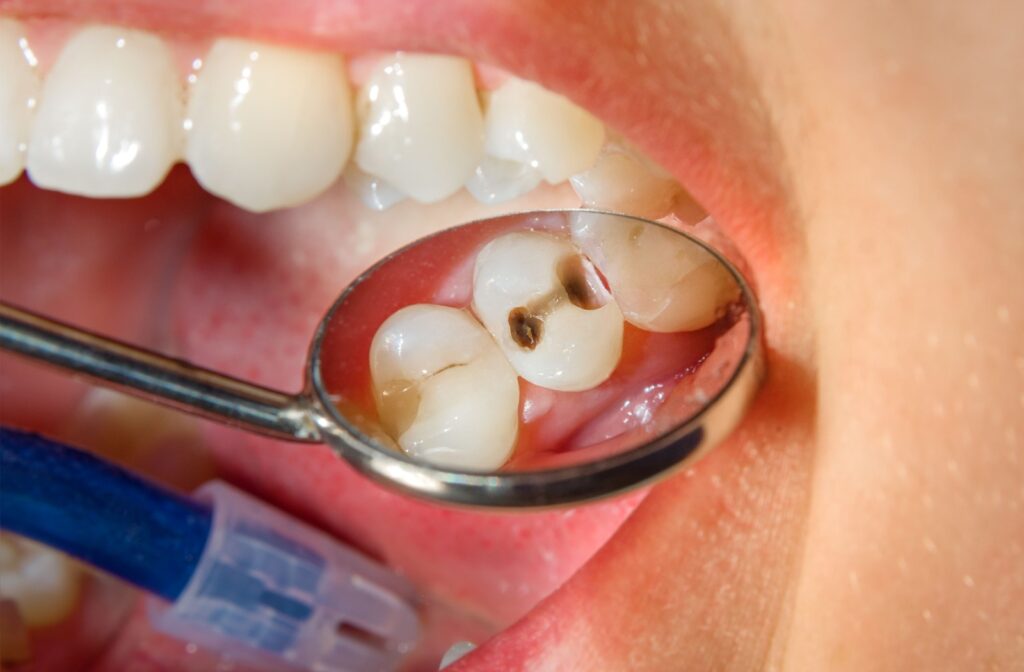A proactive approach to preventing cavities is having regular dental exams and cleanings. However, your oral hygiene practices at home and what you eat and drink can affect whether you get cavities.
If you have a cavity, a tooth filling is one of the most common dental procedures, often necessary to restore a tooth’s function and appearance.
Cavities can’t heal, making tooth fillings necessary to prevent them from getting bigger or causing pain and sensitivity. A tooth filling can take an hour or less to complete. If you have more than one cavity, you may need to book multiple appointments.
What Is a Tooth Filling?
Tooth fillings or dental fillings are typically required when a part of the tooth structure, damaged by decay, is removed. Fillings involve cleaning the cavity so no remaining decay is left and then filling the space with a material that restores the tooth’s form and function.
If a cavity is left untreated, it can become bigger, leading to pain and possible tooth loss. Signs of a cavity can include the following:
- Toothache
- Tooth sensitivity
- Tooth pain
- Noticeable holes
- Pits in the tooth
The Tooth Filling Process
The tooth-filling process begins with your dentist numbing the area around the affected tooth using a local anesthetic. Once the tooth is numb, the dentist will remove the decay and prepare the space for the filling. The filling material is shaped and polished to harmonize with your bite and neighbouring teeth.
Numbing & Preparation
The length of the initial step can vary based on the complexity of the cavity. Simple fillings may require a small amount of cleaning, while deeper or more intricate fillings could necessitate more time for preparation.
Filling Placement
This stage involves carefully applying the chosen filling material to the prepared area. Composite fillings are a type of filling material that can match the shade of your teeth for a more natural look.
Your dentist will use a special light to harden the filling and mould the material to the desired shape that fits your tooth and bite. It can be quick for minor or smooth-surfaced fillings, but more complex shapes could take longer.
Polish & Finish
After placement, the filling is polished to prevent rough edges that could interfere with the bite or cause irritation.
The Average Time for a Tooth-Filling
Tooth fillings can take an hour or less, depending on several factors.
A relatively small, single-surface filling can take 20 minutes or less, from numbing to polishing. The process can last longer for multiple surfaces or slightly larger cavities. If you have a large cavity or several cavities, fillings may require 40 minutes or more, sometimes stretching across multiple appointments if complexity demands it.
Factors That Impact the Filling Procedure Time
Various factors can affect the duration of a tooth-filling procedure, including:
- The dentist’s expertise: Experienced dentists often work more efficiently and accurately, leading to faster procedures.
- Cavity size and location: Larger cavities naturally require more extensive filling work. Cavities in easily accessible areas might allow for quicker treatment.
- Patient cooperation: Dental work can cause anxiety in some patients. However, sedation dentistry can help with dental anxiety and streamline tooth filling.
- Number of teeth requiring fillings: The overall duration will extend accordingly if multiple teeth need fillings.

Post-Filling Care
Tooth fillings are durable, but proper aftercare is essential to their longevity. Your dentist will likely recommend the following after having fillings:
- Abstain from eating or drinking for a short time. The filling may need time to set properly, so avoid chewing or eating sticky foods that can dislodge it.
- You can experience some sensitivity or soreness after a filling. For this reason, avoid very hot or cold drinks, sugary foods, and soft drinks that can increase sensitivity.
- Follow proper oral hygiene, such as brushing and flossing, to prevent further decay around the filling and keep your mouth healthy.
- Watch for signs of concern, such as unusual pain, discomfort, or changes in the bite after the numbing wears off, and notify your dentist promptly.
How to Prevent Cavities
While tooth fillings are safe and effective at saving the tooth, there are things you can do to prevent cavities in the first place. These can include:
- Brushing twice daily and flossing at least once daily.
- Using fluoride toothpaste when brushing teeth.
- Replacing your toothbrush every 3 months or when the bristles look worn.
- Eating a healthy diet and avoiding sugary foods and snacks.
- Scheduling regular dental check-ups and cleanings at least every 6 months or more often.
- Having sealants on trouble spots for decay, such as the back molars.
Tooth Preservation with Fillings
Tooth fillings can fill cavities and help restore chipped or broken teeth to preserve the tooth. The tooth-filling process is safe and shouldn’t take more than an hour.
If you or your child is experiencing tooth pain or sensitivity, book an appointment with Fairlawn Dental Centre for cavity diagnosis and prompt treatment.










